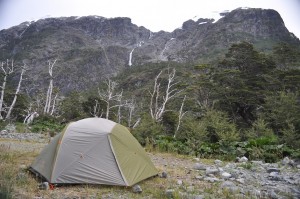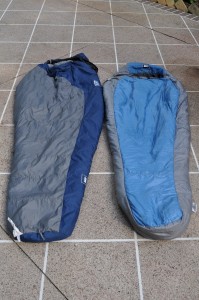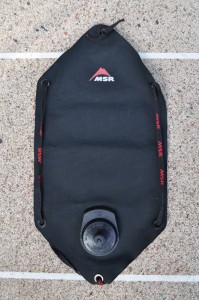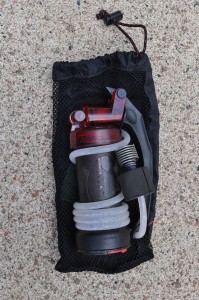On to part two of our gear review series! I’ll just jump right in… if you want some context for this, please read the last post, which explains this series and gives a detailed review of our bikes and most of the accessories that went on them. This week I’m reviewing camping gear, and next week I’ll cover clothing. Please remember the point of these reviews is not to explain WHY we purchased the item, as we highlight that information in the gear section of our web site. Here, we’re looking at how these items survived and what state they were in at the end of our 25 months on the road. Let me add this paragraph (which I have copied and pasted from part one) which explains how I’ll be classifying all our equipment:
As the Tour was coming to an end, I began mentally assessing our gear, thinking ahead to the next season when we will have income… and we’ll be able to begin replacing some of our more heavily used items. I generally created three categories into which all our things would fit:
1—Going strong, will continue to use (example: our bicycles)
2—Has seen better days, but still useable; replacement not a priority (example: our cookware)
3—Should probably be thrown away immediately (example: our cycling shorts)
So… here we go!
The Tent
Status: Complicated… see explanation below
Recommendation: See explanation below
This takes quite a bit of explaining, I’m afraid. We now have in our possession the third tent we owned over the course of our Tour. Let’s just go ahead and take a moment to thank REI here for their incredible customer service and their return policies, which, even with the newly-added reasonable one-year limit, have been helpful for us. We will continue to be their loyal customers for life!
So, let me at least aim for brevity. We started with the REI Quarterdome T3—a fantastic tent. We liked many of its features, including size, ventilation and stealthy color scheme. However, like most tents on the market these days, it was not as robust as needed for the daily rigors of cycle touring. Let’s face it: most people aren’t designing tents to be lived in. This tent suffered a zipper failure while we were in South America, about seven months into our Tour. And we knew that it was just a matter of time before other zippers followed suit. So, we emailed back and forth with REI and worked out a plan for returning it, and we exchanged it for a slight upgrade (we paid the difference)—the REI Arete ASL 3.
The Arete ASL 3 is an all-around good tent with some useful features, but it was never quite what we wanted. To be honest, if we had been able to shop in person versus the internet, we probably wouldn’t have bought it. It is an excellent choice for beginner mountaineering, with its more stout design and warmer tent walls. Unfortunately, the orange panel was bigger and brighter than it appeared in Internet photos. Even though we didn’t love it, we planned to make it work and use it until the end. However, one fateful night we camped in a storm on the top of a pass in the Swiss Alps, and this tent leaked—a lot. It was the only time it happened, and we think it was water seeping in from the bottom, as we never had issues with water coming in from the top. So, we pushed on with it until we returned to the U.S.—about six more months—and visited the first REI we found in Washington.
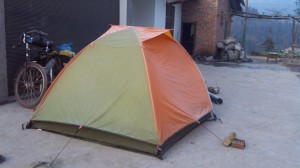
Though the Arete leaked in the Alps, we were pleased with how it held up against some of the icy and snowy conditions in China!
After much research, we selected a new tent, the NEMO Losi 3P. We enjoyed using this tent for our final four months riding home across the USA. A few details of this tent suggest to us that it might not be suitable for a full two-year tour. For example, the zippers are not as robust as we would prefer, and some of the Velcro attachments on the fly fell off under normal use. Also, we discovered that in desert conditions (i.e. Utah), very fine dust was able to work its way in through the mesh walls. (For the full account of this story, read this post about Utah.)
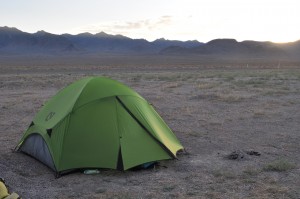
Even though we don’t think it’s strong enough to take on a multiple-year journey, we have enjoyed the Nemo immensely! One of our favorite features is how spacious it feels on the inside.
So ultimately, we would not recommend any of the tents we had for the kind of long-term Tour we did. In fact, I think there are few tents that can be recommended for such a journey, and from what we’ve heard from other travelers and cyclists, the best investment would be in a Hilleberg tent. If you click around on their site, you’ll find these are pricey tents. But if we could go back and start the Tour over, we’d have skipped the drama and hassle of replacing tents along the way, and just purchased a HIlleberg tent in the first place.
Sleeping Bags: REI Aura (for her) and REI Polar Pod (for him)
Status: Going strong
Recommendation: YES (however, the actual sleeping bags we have were given as wedding gifts, nearly five years ago! These specific products are not available, however, REI certainly offers comparable ones now.)
My sleeping bag is a slightly higher-quality model than Dave’s, and consequently, his will need to be replaced before mine. However, both of them are still intact, with seams holding up nicely and zippers fully functional. Dave thinks his might not be quite as warm as it was when we departed, and perhaps the filling is breaking down with time and use. Mine has a small tear which we need to stitch up, but that’s it. Also, we used inexpensive sleeping bag liners most of the time, which reduce skin contact with the actual sleeping bag. This helps to protect your bag from the oils of your skin which can contribute to a more rapid degradation of the material.
Thermarest Base Camp Sleeping Pads
Status: Going strong
Recommendation: YES
Our sleeping pads are still in great shape. Neither of them ever sprung a leak or had any kind of problem staying inflated. By the end of our trip they were beginning to smell funky, particularly because we had some problems with condensation on our tent floor and packed them up slightly damp on many mornings of our trip. But we’ve washed them according to the Thermarest instructions, and after letting them air out in the sun for a few days, we think they’re fine now.
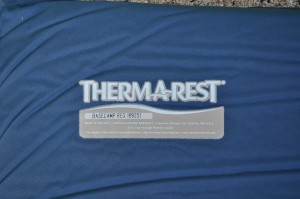
Did we also mention we actually thought these pads were pretty comfy? On more than one occasion, we rolled them out and slept on the floor rather than using a sub-par bed available to us.
REI Campware Non-Stick Cookset
Status: Seen better days
Recommendation: YES
This cookware was good to us. We certainly put it through the ringer, and not necessarily from the cooking. Let’s just say this: I have more of a tendency than Dave to tip over or drop my whole bike or find the worst bumps in the road. And I carried the cookset. So in the end, it got a rougher ride with me, which is the primary cause of its current state of wear. It has some dings and dents in it, as well as the non-stick feature having rubbed off in some areas. But it still cooks up a great pot of rice or pasta!
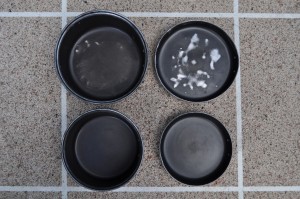
The wear is particularly evident in the bigger pot and its lid (top), as the smaller pot was often protected from daily damage because it packed inside the bigger one. The lid is mostly worn from contact with the other lid that nestled inside it during travel.
This set comes with two pots and two lids which can also double as skillets. Included is a universal handle which fits all of them. Unfortunately, the handle can only handle (no pun intended!) so much use. Ours snapped after about 14 months on the road. Fortunately, we saw it coming and arranged for a replacement before it actually broke. I would recommend carefully examining the handle for potential weaknesses before making a cookware purchase, or potentially carrying an extra handle in case of a failure.
Sea-to-Summit X-Bowls
Status: Seen better days
Recommendation: YES
These bowls are just now beginning to show some wear at the creases where they collapse (a wonderful packing feature, by the way). They have not yet started leaking, but could do so in the foreseeable future. However, they fared well considering they were piled high with hot food twice a day for the better part of two years. Also, at this point, they do not smell particularly fresh. (Understatement.) These bowls have a tendency to retain odor from whatever was last in them, and though we scrubbed and soaked them many times along the way, we never could declare them completely odorless. But seriously… it really made them fit in better with… well, with everything else we had.
MSR Dragonfly Stove
Status: Going strong
Recommendation: YES
Actually, in the spirit of full disclosure, this was the second stove of our trip. We set out with the trusty MSR Whisperlite Internationale, which was doing great, but we lost it early on. Yes, it’s a bit hard to explain, but ultimately, we misplaced this stove after unpacking and repacking our bags to fit in groceries. We’re pretty sure we left it outside a grocery store somewhere in Eastern Tennessee. So, even though we liked it, when we needed to buy a replacement, we went for the slight upgrade, the MSR Dragonfly, which offered a simmer option. We used this stove for 23 months of the Tour. We’ve done some maintenance on this stove along the way, but altogether, it’s still in great shape. We’ve had issues with it staying lit, particularly in windy conditions, but I think that is not an issue of how worn out it is, but rather just a weakness of the stove in general. So as far as strength for the journey, we’d say this stove has it!
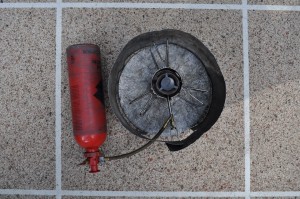
That’s the original windscreen on the stove, actually, and we recommend storing the windscreen by keeping it wrapped around the fuel bottle. Because we did that, ours never suffered the kind of damage we saw in many others that had been folded for storage purposes.
Crazy Creek Camping Chairs
Status: Going strong
Recommendation: YES
Though often criticized for carrying extra weight of chairs, we were thankful on countless occasions that we went to the trouble of carrying our Crazy Creeks. Dave actually had some trouble with his first chair, which he replaced (via family meeting us) in Peru. His second chair had a more robust design, and we’re sure it would last another few years on the road. My chair was actually already well-used before our departure… I bought it in 2004 and used it frequently throughout college and afterward. It is faded at this point, but that is the only real sign of wear. It is in great shape, and I hope to keep using it for another 10 years!
MSR Dromedary Bag
Status: Going strong
Recommendation: YES
This six-liter water bag came in handy on more than one occasion. We actually picked up a second one (a four-liter bag of the Ortlieb variety) in preparation for the desert of Argentina. We would fill one of these bags before stopping for the day, so when we were wild camping without a water source, we had plenty for cooking, cleaning and refilling our bottles. We used both of them (plus extra bottles) on particularly desolate stretches when we needed enough water for multiple days. We found the MSR Dromedary to be a better choice than the Ortlieb, though we had slight leaking issues with each. Ultimately, the MSR bag is stronger material, and the leaking problem with it was likely our own fault, from the way we stowed it on the bike with undue pressure on it. We replaced it (again via a family visit), and used more care from then on. After that, it did well for the rest of the Tour.
MSR MiniWorks Water Filter
Status: Going strong
Recommendation: YES
We used this water filter primarily when traveling in the developing world, and a few times when we needed water from a stream or river when wild camping in the US or Europe. In developing countries, we would filter water from the tap in a hotel or elsewhere and store it in our dromedary bag for filling and refilling our bottles. This filter requires some normal maintenance, scrubbing off the ceramic filter after use and occasionally boiling it for a more thorough cleaning. But after two years of use, we still haven’t even completely worn out the original filter. When we do eventually, we’ll just need to buy the replacement ceramic part, not the entire system. So this particular items is in fantastic shape and we highly recommend it!
Next week we’ll summarize the status of our clothing items, shoes and relevant accessories. Sorry for the delay on this post… we went out of town for a long weekend last week, and since then I have been fighting off a fierce cold. (Dave thinks it might be because of THIS change in our lifestyle over the past few months!)
Also, as a follow-up to this series, I plan to do a post with some details of the less-glamorous items we packed on our bike tour. For example, everyone’s curious about which bikes we rode, but does anyone want to know what kitchen utensils we packed for daily use? Because while the big stuff is important, it’s some of the small stuff that really makes a difference in your quality of life over the course of the journey! So, stay tuned for that.

